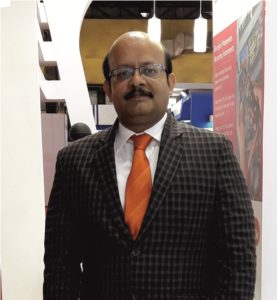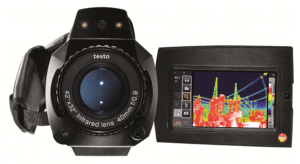Germany-based Testo is a leading name in the field of test & measurement instruments, and is renowned for its thermal imagers. Testo has been operating in India since 2006 and in a short span of time, the Indian subsidiary already holds an important position in Testo’s global portfolio, says Parag Yelegaonkar, Business Development Manager, Testo India Pvt Ltd. He also notes that with significant investment in the power T&D sector coupled with digitization of the grid, the prospects for Testo in India are very bright.
Let us start by understanding Testo’s range of T&M instruments used in the power value chain—from power generation to transmission to distribution.

At the current scenario when we are witnessing great development prospects in all the industrial areas accompanied by the infrastructural renaissance and growing power and energy concerns, the need for T&M instruments has increased significantly. Considering our latest and most advanced solutions, for instance, our new electrical instruments are very distinct and unique in their features. They are excellent instruments to inspect the electrical components and circuit failure threats during power transmission and distribution. Our latest solution to the industry is new thermal imagers with smart phone integration designed to deliver networked thermography mostly used for predictive and preventive maintenance in electric and power sector. We also have a range of smart probes which equips the users with smart and easy measurement techniques using smart phone interface. It can get integrated to the thermal imagers and can ensure instant testing and measurements.
Wireless operation, with the easy of saving and transferring data over networks makes our instrument more user-friendly, interactive and cost effective. Our continuous approach towards innovation and R&D ensures eminent future of our products which are sure to redefine the overall working experience of T&M in the power domain.
We understand that Testo equipment marketed in India is sourced from the parent company’s factory in Germany. Are there plans to manufacture in India, at least with some products to start with?
We have our manufacturing in Germany and thus the R&D is taken care at the headquarters itself. As of now we don’t have any plans to set up a manufacturing facility in India as the process in which we operate is very stable and hassle free. But in India, we do offer certified calibration according to all valid guidelines. The calibrations take place at Testo’s own accredited high-tech laboratory at our facility in Pune so that the instruments can be calibrated and serviced locally whilst maintaining international standards.
Testo thermal imagers are significantly different from the rest available in the market as we have come up with more advanced and latest technologies.
Thermal imagers, as we perceive, have been Testo’s strength. Firstly, tell us in brief about how thermal imagers work.
Thermal cameras usually detect radiation in the long-infrared range of the electromagnetic spectrum and produce images of that radiation. Infrared radiation is emitted by all objects and thermal imagers capture these radiations and develop a thermal imprint of the object. This phenomenon is known as thermography which makes it possible to see one’s environment in the form of color patterns. The amount of radiation emitted by an object increases with temperature; therefore, thermography allows one to see variations in temperature by using thermal imagers.
How has Testo been able to consistently maintain its edge over competition, in the field of thermal imagers?

Testo thermal imagers are significantly different from the rest available in the market as we have come up with more advanced and latest technologies. Testo provides multiple variants of its high-end thermal imagers which are the best solution for transmission lines and power sector. Our latest addition is the range of imagers that provide unbeatable price-performance ratio and are not only precise or efficient but are also smart and networked. There are several unique features in our thermal imagers such as they provide objectively comparable and error-free thermal images, automatic determination of emissivity and reflected temperature values etc.
The new range of testo thermal imagers defines a clear exclamation mark in the tough thermal imager market; they have resolution of up to 320×240 pixels with an excellent price to performance ratio. With the testo super resolution technology included as standard, this can even be increased at a PC to 640×480 pixels. No comparable thermal imager has better image quality and price-performance ratio.
Could you explain how thermal imagers are useful in testing of solar photovoltaic equipment?
A solar photovoltaic setup is made up of small arrays of panels that use solar energy to generate power. During inspections and preventive maintenance of the setup, Testo thermal imagers play a crucial role and identify the defects in solar cells at module level for the possible cracks, voids, open and short circuit of the tracks in solar cell joining/junctions. These solar thermography inspections can fairly highlight the hot and cold spots and avoid loss of entire array and string efficiency. Regular testing and measurement looks indispensable and our thermal imagers ensure proper functioning of the set up without any breakdown whatsoever.
With the shift in the manufacturing technology, our role has also changed considerably and we continuously keep developing better solutions for emission analysis.
How do you see the business potential of flue gas analyzers, given the stringent emission standards that are evolving in India?
Things are not same as they used to be. With more focus on energy conservation and sustainable development, the industry has experienced uplift. Controlled emissions, reduced wastage, restricted energy usage, energy audits and inspections are now of prime concern. The government has also taken several measures to conserve resources and save energy. Since methods have changed significantly and norms have become more stringent, so have the requirements for monitoring and emission analysis. Testo flue gas analyzers which help to save fuel and promote energy conservation have gone a level up with testo 330i- the flue gas analyzer. It is available with the provision for wireless operation, display and documentation which can be intuitively operated by smart phone via a free app. This is just the opening of the new gateway to digitization. With the shift in the manufacturing technology, our role has also changed considerably and we continuously keep developing better solutions for emission analysis.
It is generally perceived that the penetration of the T&M industry in India is limited. What do you think? Do you also share the view that the presence of multinationals in the Indian manufacturing sector can potentially deepen the penetration of the T&M industry?
Yes, there was a time when the T&M industry was not deep rooted as most of the systems and operations were manually driven. Also, the technology was very elementary and under developed. But times have changed now and with digital being the new trend, the advancements are overwhelming. Traditional methods and processes are now getting replaced with smart solutions, governed with just one click of the smart phone. The processes have become more easy, accurate, fast and reliable. Inclusion of measurement techniques via Bluetooth/WiFi, cloud storage and other IoT concepts has taken the measurement industry by storm. Another aspect that ensures the growth of T&M industries is the increasing application areas and data monitoring necessities in the emerging MNCs in the Indian market.
There is an abundance of low-cost Chinese T&M equipment, especially the hand-held ones, in India. What impact has this had on reputed brands?
During the last couple of years, we have been observing the Chinese T&M manufacturing industries have entered into Indian market. The prices offered by these players are very cheap due to which the reputed brands and MNCs do suffer a setback. Even in government tenders, where the L-1 bidder is awarded the contract, premium brands suffer significant losses. In the long run this situation might not be favorable for these superior brands. If you see the scenario in private organizations and non-technical individuals, majority of the people opt for Chinese instruments because of the cheaper options.
To meet the energy production targets, the infrastructure and facilities of these relevant sectors are getting revamped at a very faster pace which ultimately demands for the establishment of smart grid and advanced T&M equipment.
At the same time, are users gradually appreciating the cost-quality relationship?
Though the cost of the product is an important aspect but it is just one half of the story. There is a big question mark on the long-term performance of Chinese equipment and compromise on quality, safety and longevity of the products. Also, the T&M business is service oriented and the service by Chinese companies is comparatively less reliable. Because of this companies now prefer to pay a little more but stay secure. Few government organizations have also started new tendering system which is “quality-cost based system” that considers not only the cost of the product but also the performance assurance and quality. Even the direct end-users are required to review each and every aspect of the equipment they purchase, which will be beneficial for them in the long run.
The power sector is witnessing massive investment, especially in the T&D domain. There is also a conscious effort to move into Smart Grid architecture. Given this, how important will be the power industry with respect to Testo’s growth in India?

The power sector is investing in solar and hydro energy to meet the renewable energy target. Also, the public sector thermal power plants are investing in solar and wind energy to match their renewable energy obligations. Somewhere this puts excessive load on the existing infrastructure of transmission lines and switchyards. To meet the energy production targets, the infrastructure and facilities of these relevant sectors are getting revamped at a very faster pace which ultimately demands for the establishment of smart grid and advanced T&M equipment. Our growth is directly related to this development.
We provide smart solutions for T&M to make the system asset available 24×7 without interruptions. During the installation phase of any power plant our T&M equipment are very much required and used in setting up benchmark parameters for various process tags. One can as well derive the optimum efficiency of each power infrastructure equipment and record the measured parameter values by using T&M equipment for future use looking in to consistency in optimum operation and for all kinds of trouble shooting jobs.
Testo thermal imagers and electrical instruments ensure preventive and predictive maintenance of the facility and increase the efficiency. Instruments offered by Testo are having an edge over the other available T&M instruments because of value for money, their robust and smart features along with precise reporting software.
Currently, what is India’s share in Testo’s global portfolio? Do you see this share rising in the coming years?
India is termed as an emerging market and the numbers are only growing. In a very short span of time from its inception, Testo India grew from a small-sized subsidiary of Testo SE & Co KGaA to a mid-sized one. Our exponential growth is very well recognized globally and recently we secured a confirm place in the band of large Testo subsidiaries. Our customer service and marketing activities are well appreciated by our parent company. With continuous growth in the market Testo India holds a prominent position in Testo’s global portfolio.


